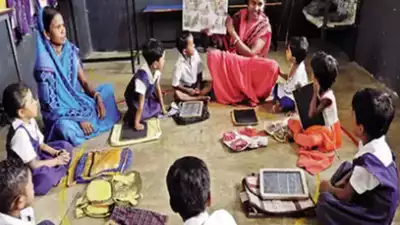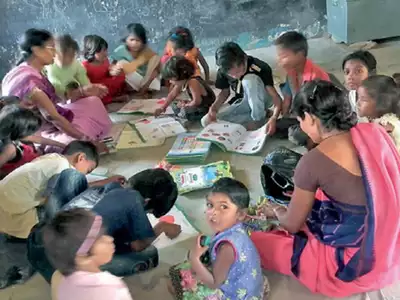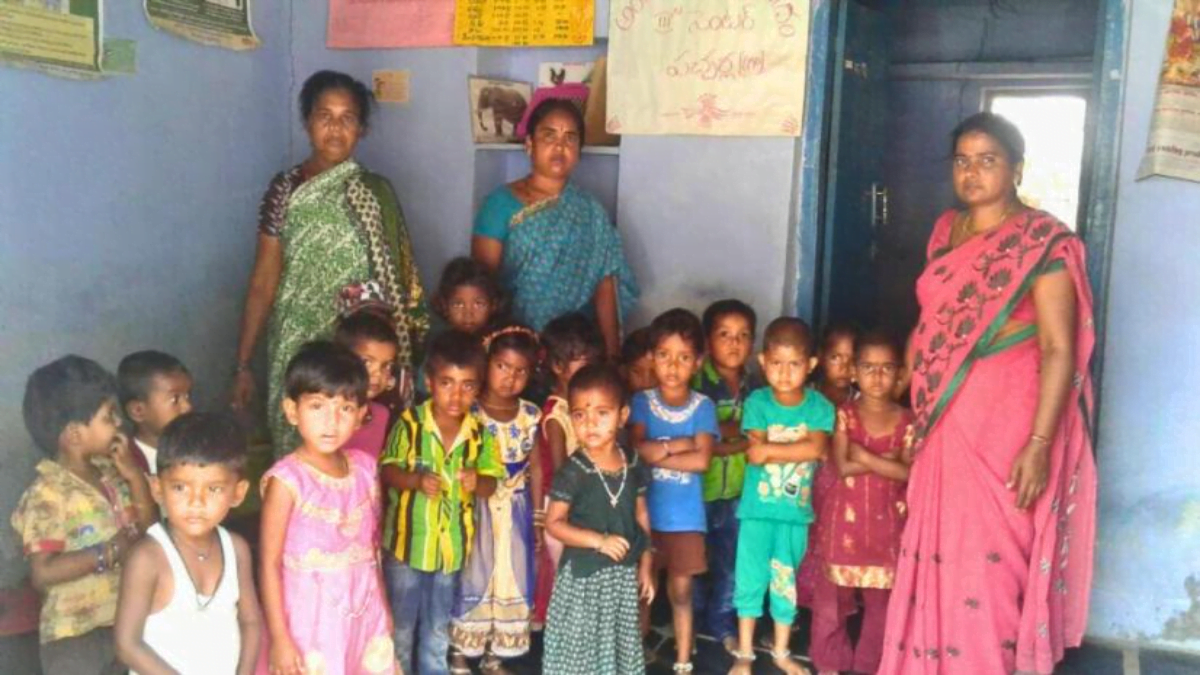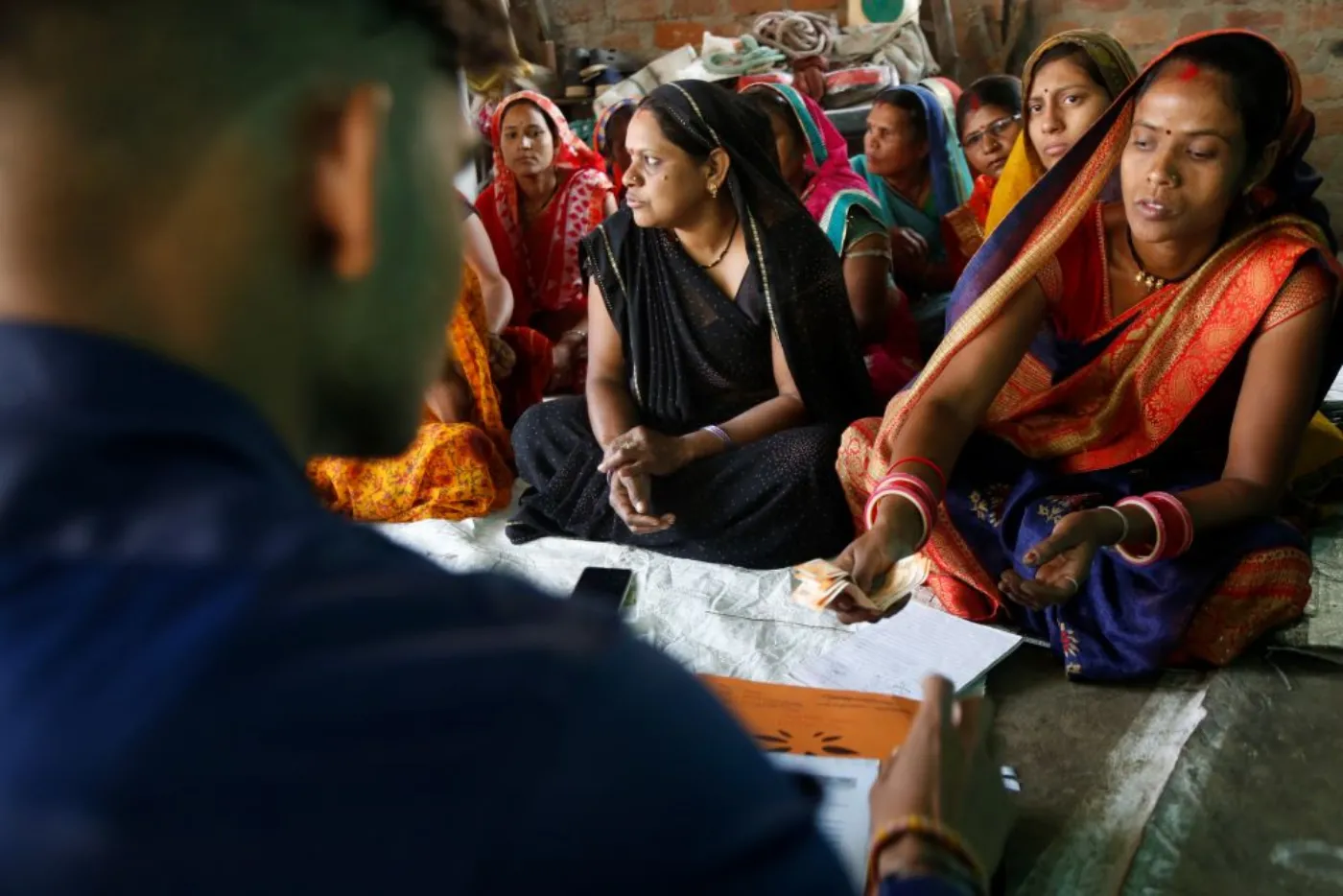Hyderabad, Telangana: Akula Buvvamma alias Mohammad Mahboobi (53) has a busy morning schedule. Waking up at 6 am, one of the first things she does is to fetch water from a public tap, installed under Mission Bhagiratha near the anganwadi centre in Pacharla BC Colony in Jogulamba Gadwal district of Telangana.
She walks half-a-kilometre from her house in Pacharla village and collects three pots of clean drinking water, which she will use for cooking and cleaning at the anganwadi centre that day.
Once done with the chore, she hurriedly returns to clean the house, take a bath and make tea. She also cooks and packs her lunch of rice and curry, before setting out for the anganwadi centre again, mostly by 8.30 am.
Earlier, the caste system used to work hard and fast here and no one was interested in tending to the children from lower castes. As Mahboobi showed willingness, she managed to get the job.
By 9 am, in her position as an anganwadi helper, she assembles the slum dwellers’ children aged between seven months and six years and makes them sit for preschool activities. Earlier, the caste system used to work hard and fast here and no one was interested in tending to the children from lower castes. As Mahboobi showed willingness, she managed to get the job.

Mahboobi immerses herself in work until 4 pm — boiling milk and eggs for the 25 children in attendance, cooking nutritious food for them as well as the pregnant/lactating mothers visiting the Centre, doing dishes, cleaning the premises and putting the tiny tots to sleep after their lunch at 12 pm. Every child gets 120 ml of milk and an egg daily. However, the hard work she puts in does not match with the honorarium of Rs 7,800 she receives every month.
‘I joined the anganwadi centre in 2007, two years after my husband died. I was paid nothing in the first two years. Finally, some relief from financial stress came when I started receiving a monthly honorarium of Rs 4,500 in 2009,’ says Mahboobi, who used to sell betel leaves earlier to raise her two sons and three daughters.
With her children moving out after marriage, she now lives alone. Her biggest fear is that she would end up not receiving gratuity during retirement. ‘My salary will not be enough to deal with future scenarios, including diseases,’ she frets.

Nothing comes without a fight
At every protest they hold, anganwadi teachers and helpers raise their voices seeking gratuity. They seek recognition as full-time government employees, who get wages under the Payment of Wages Act, 1936, and not honorarium.
An anganwadi teacher is paid Rs 12,000 per month, which translates to Rs 460 a day. Similarly, a helper’s daily wage is Rs 300. The Central and state governments contribute in the ratio of 60:40 to make these payments.
An anganwadi teacher is paid Rs 12,000 per month, which translates to Rs 460 a day. Similarly, a helper’s daily wage is Rs 300. The Central and state governments contribute in the ratio of 60:40 to make these payments. Sadly, the honorariums are no match for the minimum wage of Rs 800 that a daily wage labourer in Telangana receives.

Hence, the Telangana Anganwadi Teachers and Helpers Union (affiliated to Centre for Indian Trade Unions) have been demanding that anganwadi teachers be paid Rs 26,000 and helpers Rs 20,000 per month. It will launch an indefinite strike on September 11 to make the state government act on their demands, which include retirement benefits of Rs 10 lakh to teachers and Rs 5 lakh to helpers.
A landmark judgment from the Supreme Court (SC) last year raised their hopes in this regard. In its April 25 order, the SC observed that anganwadi workers and helpers were entitled to the payment of gratuity under the Payment of Gratuity Act, 1972. The court also directed disbursal of gratuity to all eligible employees within three months with 10% simple interest.
It also noted that anganwadis worked as an arm of government and took responsibility for the proper implementation of the provisions of the Right to Education Act and the National Food Security Act.

In a bid to firefight, besides finding a loophole, the Telangana government recently announced a financial assistance of Rs 1 lakh to retiring anganwadi teachers and Rs 50,000 to mini anganwadi teachers and helpers. On the other hand, it also raised the retirement age of anganwadi teachers and helpers to 65 years from the earlier 57.
It should be noted that term ‘gratuity’ was not used for the financial assistance, which anyways will be a much bigger sum than the amount announced. For example, if a helper’s last drawn salary is ₹7,800 and she has completed 30 years of service, the gratuity contribution would be Rs 1,35,000. For an anganwadi teacher with similar experience, the gratuity contribution comes to Rs 2,07,692.
As many as 34,148 anganwadi centres are present across Telangana, with each anganwadi supposed to have a teacher and helper. However, only 33,843 teachers and 27,990 helpers are on duty. The remaining posts are vacant.
As many as 34,148 anganwadi centres are present across Telangana, with each anganwadi supposed to have a teacher and helper. However, only 33,843 teachers and 27,990 helpers are on duty. The remaining posts are vacant.
No job security, health cards
Being the torchbearers of government schemes related to education and health under the Integrated Child Development Services (ICDS), the compensation for their critical work does not match with the importance of their roles. Health card, pension and job security are still unattainable for the predominantly female anganwadi workforce. They have also been seeking more budget allocation for the ICDS.

Lack of money or health card to treat diseases leads to deaths at times. Take the case of Padma Kolas (46), an anganwadi helper from Maddulapalli village in Khammam Rural mandal. Last month, she succumbed to dengue, leaving behind two children aged below eight years. Similarly, cases where funerals got delayed due to want of money have also been reported.
Boya Manikyamma (55) is an anganwadi helper at the Comprehensive Women Child Welfare Development Anganwadi Centre in Jyotinagar 2 of Khairatabad mandal in Hyderabad district. ‘This is my 26th year of service. I suffer from leg and back pain. The officials say we can take voluntary retirement if we want. But how can I leave with empty hands? How shall I live after that?‘ says Manikyamma, who stays with one of her three children.

The nutritional status of women and children in the state have improved through the concerted efforts of anganwadi workers, though it has not achieved the set target to reduce anaemia. The percentages of underweight children aged less than three years and anaemic pregnant women are still high. As a result, reduction of Infant Mortality Rate (IMR) and Maternal Mortality Rate (MMR) continues to be a challenge.
A Press Information Bureau release, dated February 8, 2022, shows how IMR in Telangana has come down from 34 in 2015 to 23 in 2019 per 1,000 live births. In fact, Telangana Health Minister Thanneeru Harish Rao claimed on Twitter last November that Telangana ranked third in the country in the reduction of IMR and MMR.
Despite the good work, anganwadi workers are yet to receive their dues. When they will get it depends mainly on the state and Central government’s willingness to recognise their role as frontline workers in educating the marginalised, ensuring their nutrition and thereby securing their health in future. Until then, people like Mahboobi and Manikyamma will continue to suffer.
About the author(s)
101Reporters is a pan-India network of grassroots reporters that brings out unheard stories from the hinterland.






